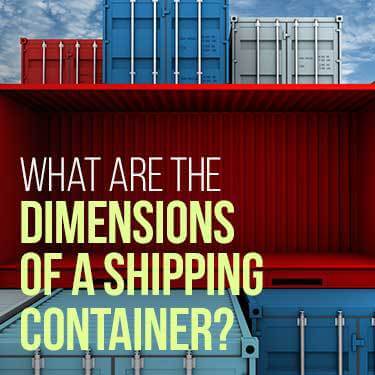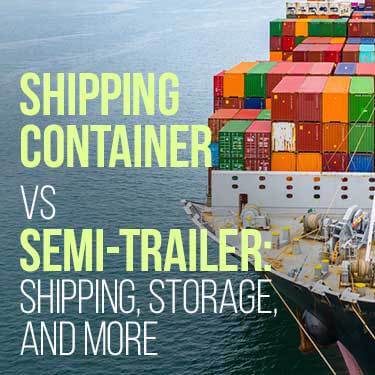Shipping containers and semi-trailers are some of the most recognizable storage units in the shipping industry. Both of these units carry the goods of shippers all over the world. However, there are plenty of differences between the two that creates a container vs trailer competition.
Semi-trailers win dimension variety in the container vs trailer battle due to their many lengths. However, shipping containers and trailers have a similar maximum weight capacity. If need be, a container can be utilized as a trailer if attached to a flatbed trailer. Which is best to use depends on your shipping needs.
Learn more about the variations between shipping containers and trailers and which works best for you.

Many different types of semi-trailers can carry different types of loads. Semi-trailers also have various lengths such as the following ones:
There are no federal regulations regarding the length of semi-trailers. The limit to how long semi-trailers can be in the U.S. varies by state. Some allow for trailers to be 57 feet and longer.
However, the most common type of semi-trailer used in the U.S. is the 53-foot dry van. This particular semi-trailer also has a height and width of about 8.2 feet.
The maximum load capacity can vary by a semi-trailer. Typically, the longer a semi-trailer is, the more weight, pallets and loose packages it will be able to transport.
The 53-foot dry van trailer can carry between 42,000 and 45,000 pounds of weight. This type of trailer can also fit a considerably large amount of pallets and packages in it.
These trailers can also carry 26 standard 48 by 40 inch pallets. However, you could double the number of pallets you ship on this type of dry van trailer by double stacking your pallets.
This would bring the total amount of standard pallets a 53-foot dry van can carry up to 52 pallets. When you double-stack pallets, you will need to make sure that they do not exceed nine feet since that is the height of most dry vans.
If anything, leave a few inches of space between the ceiling of the trailer and the top of the pallet. You will also need to make sure that double stacking pallets won’t cause your shipment to exceed the trailer's weight limit.
There’s also plenty of storage space for non-palletized freight in 53-foot dry van trailers. Depending on the size of the packages, you can fit around 1,000 to 2,000 packages into this type of trailer.

Like with semi-trailers, there is a wide range of shipping containers that are used for different purposes. The most common container that is used is the dry container.
There are three length variations of the standard container. Those variations are:
There is a slight height difference between a regular shipping container and a high cube. High cubes are higher than containers by one foot and can also come in 20 to 40-foot length variations. Standard shipping containers are slightly over eight and a half feet high while the high cube is nine feet and six inches.
Dry containers can carry weight similar to that of semi-trailers. The maximum weight is between 44,000 and 44,500 pounds.
Dry containers and cubes carry a smaller amount of pallets than the common 53-foot dry van trailers. The 20-foot dry container or cube can hold up to 10 standard 48 by 40 inch pallets while the 40 foot can carry 20 standard pallets.
Dry containers always transport palletized freight instead of non-palletized freight. That said, you can still get a good estimate about the number of packages a dry container will be transporting.
A 20-foot dry container can hold about 10 standard 48x40 single stacked pallets. Standard pallets with this measurement can carry 60 boxes. This means the 20-foot dry container can carry on average 600 boxes.
The 40-foot dry container can carry 20 single stacked standard pallets. Since the number of pallets is doubled, so is the amount of boxes that can be carried on them. Therefore, the 40-foot dry container can carry an average of 1,200 boxes.
You can double stack pallets in dry containers. Doing so will not only double the number of pallets you can ship in each container, but it also doubles the number of boxes as represented by our table below.
| Dry Container | Standard Pallet | Amount of Boxes |
| 20 feet | Single Stacked Pallet | 600 |
| 40 feet | Single Stacked Pallet | 1,200 |
| 20 feet | Double Stacked Pallet | 1,200 |
| 40 feet | Double Stacked Pallet | 2,400 |
Shipping containers can be utilized as trailers if the circumstances call for it. A 40-foot shipping container could easily fit on a flatbed trailer with plenty of room to spare.
Using a trailer to transport a shipping container is useful when you need to unload a container onto a loading dock. The loading and unloading of containers occur at the ground level which makes it impossible for them to be at the same level as the dock itself.
Securing a shipping container to a trailer allows that shipping container to be loaded and unloaded at the same level as a dock. Another reason a container could be utilized as a trailer is for drayage purposes.
Drayage is when a container in a port is transported a short distance using a chassis that is designed to move containers. Drayage is a service we R+L Global Logistics provides.
You can learn more about drayage in our article: The Full Breakdown of Port Drayage.

As far as storage options go, the commonly used 53-foot dry van trailer can carry more packages and pallets than a 40-foot dry container. Trailers not only let you ship more, but they allow you to load your freight using palletized or non-palletized freight.
Shipping costs for containers are much more expensive than shipping expenses for semi-trailers. Many ships will charge somewhere between $2,000 to $3,000 to transport shipping containers. Prices can fluctuate based on how full the containers are.
Securing a shipping container to a trailer would create additional costs. Despite how expensive shipping by the container can be, it is often necessary to use one when shipping goods overseas.
The cost to ship using a semi-trailer is cheaper. While costs can fluctuate depending on what you're shipping, you will more than likely be paying much less than you would be for a shipping container.
The delivery time for goods that are shipped using both containers and trailers now takes longer than they ever have. The reason for this is due to port congestion.
Ships carrying shipping containers are stuck out at sea waiting for their turn to come into port and unload their goods. Because ports are so backed up and wait times are so long, it takes more time for goods to be put on a trailer and get sent where they need to go.
While shipping goods using a semi-trailer seems to have more benefits than a container, this isn’t necessarily the case. What determines if a trailer or container is better comes down to what you need based on your shipping circumstances.
Regardless of where you stand on the shipping container vs semi-trailer debate, you can count on R+L Global Logistics to transport your goods quickly and effectively. Providing excellent customer service is an important part of our job R+L Global Logistics.
To deliver that customer service, we take the time to get to know you and what your needs are. We won’t let the current port congestion prevent us from transporting your goods promptly.
Our logistics experience and knowledge allow us to utilize the quickest and most cost-effective shipping routes. So, start your relationship with us today by filling out a quote on our truckload page.
R+L Global Logistics
315 NE 14th St., Ocala, FL 34470